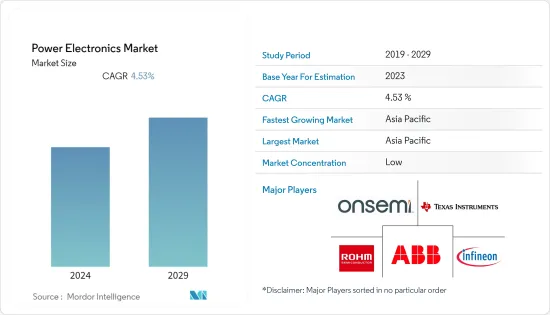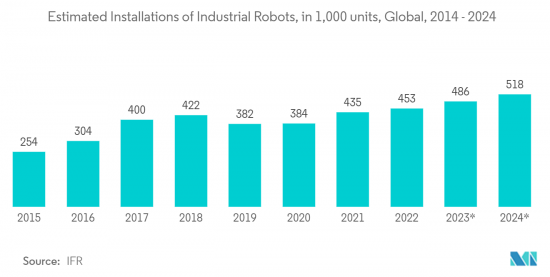PUBLISHER: Mordor Intelligence | PRODUCT CODE: 1404525

PUBLISHER: Mordor Intelligence | PRODUCT CODE: 1404525
Power Electronics - Market Share Analysis, Industry Trends & Statistics, Growth Forecasts 2024 - 2029

The power electronics market is estimated at USD 29.19 billion in the previous year. The market is expected to reach USD 37.72 billion over the forecast period, registering a CAGR of 4.53%. This growing demand for power electronics comes from various booming applications, including electric and hybrid electric vehicles (xEV), factory automation, photovoltaics, wind turbines, UPS, and home appliances.
Key Highlights
- Notably, electrical energy consumption continues to grow, and more applications are being introduced based on electricity. More than 60 percent of total energy consumption is expected to be converted into electricity for use, and electrical energy must be produced, distributed, and used as efficiently as possible. Further, emerging climate change also argues for finding future sustainable solutions. Under such evolving circumstances, two major technologies that are likely to play essential roles in solving parts of those future problems include the change in electrical power production from conventional, fossil (and short-term) based energy sources to renewable energy sources and usage of highly efficient power electronics in power transmission/distribution, power generation, and end-user application, thus driving the role of power electronics.
- The power electronics industry is experiencing a dynamic environment that is constantly changing due to numerous trends. As power electronic devices and systems exist throughout the power supply chain, from the power plant to the entire power grid, the factors that influence them can vary widely. And then to items that consume electricity. All are very different environments and are affected differently.
- Reducing energy consumption is one of the major trends impacting the energy industry, and power electronics are emerging as a key technology to precisely control the flow of electrical energy from the source to the load, depending on the load requirements. Thus, it is responsible for the reliability and stability of the whole power supply infrastructure from the sources, the energy transmission and distribution up to the huge variety of applications in the industry, transportation systems, and home and office appliances.
- For instance, advanced power electronics could realize savings of about 50 percent of the energy losses in converting from mains or battery voltages to those being utilized in electronic equipment. But despite the tremendous importance of power electronics, there needs to be more awareness of the role of power electronics in modern industrial society, even in the well-informed general public.
- The pandemic also accelerated the adoption of IoT, which positively impacted the market. For instance, a recent study by global mobile satellite provider Inmarsat found that the maturity of companies adopting the Industrial Internet of Things (IoT) has increased rapidly since the start of the COVID-19 pandemic.
Power Electronics Market Trends
Rising Demand for High-energy and Power-efficient Devices in the Electronics Segment is Expected to Drive the Market Growth
- Industrial appliances such as uninterruptible power supplies (UPS), server power supplies, power converters, and motor drives consume a significant portion of the world's power. Therefore, any increase in efficiency in industrial power supplies will substantially reduce a company's operating costs. With greater power density and better thermal performance, the demand for high-efficiency power supplies is increasing exponentially.
- Currently, one of the most popular applications for power semiconductors is uninterruptible power supplies. It is typically used to protect hardware such as computers, data centers, communications equipment, and other electrical equipment where an unexpected power failure could result in injury, death, critical business loss, and interruption or loss of data. Uninterruptible power supply systems usually contain batteries and an inverter that uses IGBT (insulated-gate bipolar transistor).
- The need for high-efficiency power sources is growing at a rapid pace. Several causes are fueling this expansion. The first is a growing global awareness of the importance of using energy efficiently and wisely. Power semiconductors for controlling electric power are attracting wider applications and increasing demand as key devices that can help lower a global society's carbon footprint.
- Electric motor drives are one of the key elements in any industry. They drive pumps, fans, and conveyor belts, move hoisting vehicles and elevators, and are used to the same extent to generate compressed air or refrigeration. Owing to their widespread deployment, electric drives account for a significant portion of the power used in the industry.
- Using efficient power semiconductors allows for the design of effective, reliable, and multi-dimensional robots. Thus, increasing the installation of industrial robots creates a positive outlook for the market. According to the International Federation of Robotics (IFR), robot installations worldwide recovered strongly the year before, making it the most successful year ever for the robotics industry. With the continued trend toward automation and continued technological innovation, demand has reached high levels across the industry.

Asia-Pacific Expected to be the Fastest Growing Region
- The Asia-Pacific region dominated the electronic power market in the previous year and is expected to grow considerably and continue dominating over the forecast period. The lucrative opportunities in consumer electronics, automotive, telecom, and industrial applications in the Asia-Pacific region are responsible for the sizeable market share and regional growth.
- The region of Asia-Pacific is anticipated to dominate the market studied because it currently dominates the global semiconductor market, further supported by government policies. According to SIA, China, Japan, Taiwan, and South Korea account for about 75 percent of the world's semiconductor production collectively, and other countries like Vietnam, Thailand, Malaysia, and Singapore also make significant contributions to the region's market dominance.
- In April 2023, the PowerUP Asia conference and exhibition highlighted the most recent technological developments and trends in power electronics, including WBG devices, power semiconductors, and related technologies. It stated that the growing electric vehicle (EV) industry, rising calls for renewable energy adoption, industrial automation trends, and rising consumer electronics demand are all fueling the growth of the power electronics industry as manufacturers focus on power efficiency, carbon reduction, and 'greener' energy.
- Power electronics are becoming increasingly common in EVs, requiring high-power energy to rotate electric motors. Power components like MOSFETs (metal-oxide-semiconductor field-effect transistors) and IGBT are power electronic switches in power train systems. The significant market growth can be attributed to the rising demand for energy-efficient hybrid electric vehicles in several nations, including India, China, Japan, and others, to reduce the effects of rising environmental pollution.
- For instance, China's automotive sector has increased, and the region plays a more significant role in the global auto industry. China is one of the top countries to adopt electric vehicles, which are becoming increasingly popular. In 2022, China sold 5.67 million EVs (electronic vehicles) and plug-ins, according to the China Passenger Car Association, as consumers switched from gas-guzzler models due to government subsidies and high oil prices. With the EV industry, it is anticipated that demand for power electronics will increase quickly.
- In addition, the market for power electronics in Japan is rapidly growing due to developments in several industries, including transportation, renewable energy, and other fields where power electronics have a wide range of applications. As a result, it is anticipated that the Japanese automotive industry, which is expanding quickly due to demand for electric vehicles, will be the primary driver of opportunities for power electronics in the region.
Power Electronics Industry Overview
The intensity of competitive rivalry in the power electronics market is expected to be high and remain unchanged over the forecast period. The market comprises several global and popular players, such as ON Semiconductor, Infineon, ROHM, STMicroelectronics NV, and others. Although the market poses moderately high barriers to entry for new players, several new entrants have gained traction.
In May 2023, Infineon launched CoolSiC power modules using 3.3 kV MOSFETs in the XHP 2 package for traction applications. The FF2000UXTR33T2M1 and FF2600UXTR33T2M1 power modules use newly developed 3.3 kV CoolSiC MOSFETs and Infineon's XT interconnection technology. The modules come in an XHP 2 package specifically tailored for traction applications.
In May 2023, Mitsubishi Electric Corporation developed a new structure for a silicon carbide metal-oxide-semiconductor field-effect transistor (SiC-MOSFET) embedded with a Schottky barrier diode (SBD), which the company has applied in a 3.3 kV full SiC power module, the FMF800DC-66BEW for large industrial equipment such as railways and DC power systems.
In January 2023, Renesas Electronics announced a new gate driver IC designed to drive high-voltage power devices such as IGBTs (insulated gate transistors) and SiC (silicon carbide) MOSFETs for electric vehicle (EV) inverters. Moreover, As electric vehicles become more affordable, demand for automotive power semiconductors is increasing rapidly. The business continually increases its market share by providing various products to meet demand.
Additional Benefits:
- The market estimate (ME) sheet in Excel format
- 3 months of analyst support
TABLE OF CONTENTS
1 INTRODUCTION
- 1.1 Study Assumptions and Market Definition
- 1.2 Scope of the Study
2 RESEARCH METHODOLOGY
3 EXECUTIVE SUMMARY
4 MARKET INSIGHTS
- 4.1 Market Overview
- 4.2 Industry Attractiveness - Porter's Five Forces Analysis
- 4.2.1 Bargaining Power of Suppliers
- 4.2.2 Bargaining Power of Buyers
- 4.2.3 Threat of New Entrants
- 4.2.4 Threat of Substitutes
- 4.2.5 Intensity of Competitive Rivalry
- 4.3 Assessment of COVID -19 impact on the Industry
- 4.4 Technology Snapshot
- 4.4.1 Power Generation and Storage
- 4.4.2 Sensing and Measurement
- 4.4.3 Power Management and Distribution
- 4.4.4 Other Functions
5 MARKET DYNAMICS
- 5.1 Market Drivers
- 5.1.1 Rising Demand for High-energy and Power-efficient Devices in the Electronics Segment
- 5.1.2 Demand for Green Energy Power Generation Drives
- 5.2 Market Restraints
- 5.2.1 Rising Demand for Integrated Circuits
6 MARKET SEGMENTATION
- 6.1 By Component
- 6.1.1 Discrete
- 6.1.2 Module
- 6.2 By Material
- 6.2.1 Silicon/Germanium
- 6.2.2 Silicon Carbide (SiC)
- 6.2.3 Gallium Nitride (GaN)
- 6.3 By End-user Industry
- 6.3.1 Automotive
- 6.3.2 Consumer Electronics
- 6.3.3 IT and Telecommunication
- 6.3.4 Military and Aerospace
- 6.3.5 Industrial
- 6.3.6 Energy and Power
- 6.3.7 Other End-user Industries
- 6.4 By Geography
- 6.4.1 North America
- 6.4.2 Europe
- 6.4.3 Asia-Pacific
- 6.4.4 Latin America
- 6.4.5 Middle East and Africa
7 COMPETITIVE LANDSCAPE
- 7.1 Company Profiles
- 7.1.1 ON Semiconductor Corporation
- 7.1.2 ABB Ltd.
- 7.1.3 Infineon Technologies AG
- 7.1.4 Texas instruments Inc.
- 7.1.5 ROHM Co. Ltd
- 7.1.6 STMicroelectronics NV
- 7.1.7 Renesas electronic corporation
- 7.1.8 Vishay Intertechnologies Inc.
- 7.1.9 Toshiba Corporation
- 7.1.10 Mitsubishi Electric Corporation
8 VENDORS MARKET SHARE ANALYSIS
9 INVESTMENT ANALYSIS
10 FUTURE OF THE MARKET




